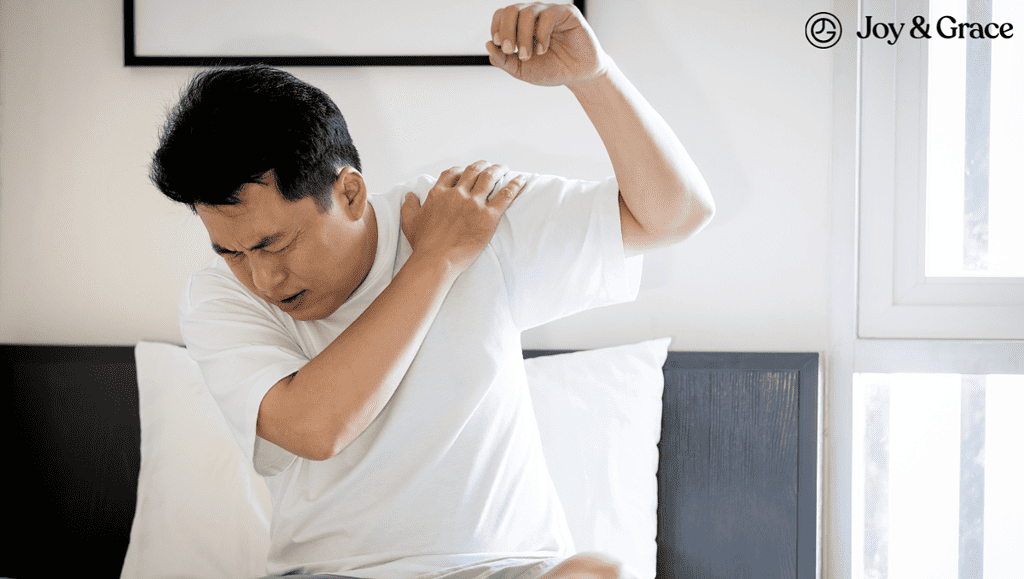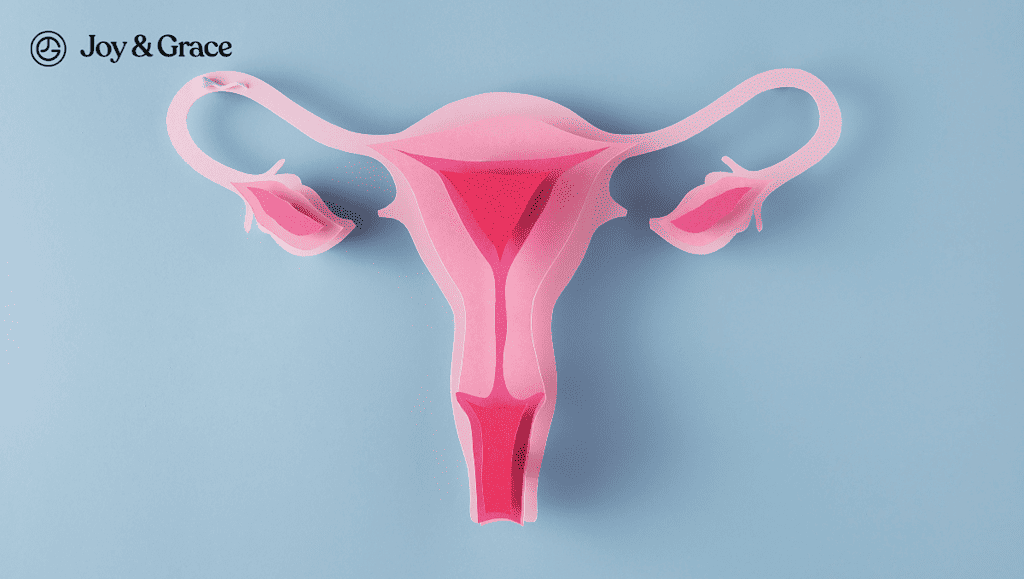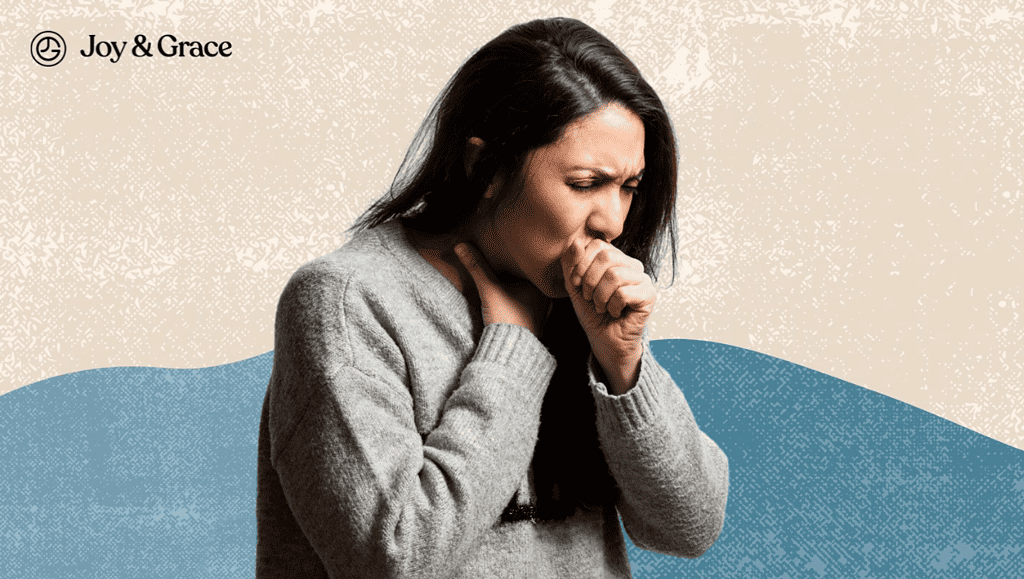You've had a good night's sleep, but instead of feeling refreshed, you're greeted with an unwelcome guest: pain in your shoulder blade.
Uncomfortable and bewildering, this type of pain can impact your mood and overall well-being.
So, what's causing this discomfort? Let's delve into the reasons behind shoulder blade pain after sleeping and discover the most effective ways to reduce and prevent it.
Why Does My Shoulder Blade Hurt After Sleeping?
Pain in the shoulder blade after sleeping can stem from several factors, often related to your sleeping habits and poor posture. If your body isn't in the right position while you sleep, it can put extra pressure on your soft tissues and joints.
For instance, when people sleep on their side, they often sleep on their shoulder in a way that puts pressure on their rotator cuff tendons or shoulder bursae. This can cause pain behind your shoulder blade when you wake up.
The same is true for people who sleep on their backs but don't have the right pillow height.
These claims are also supported by a 2017 study that suggested that proper sleeping posture is important for preventing neck and shoulder pain.
Other causes of shoulder blade pain after sleeping include the following:
- Pre-existing shoulder conditions such as rotator cuff injuries or osteoarthritis.
If you have shoulder joint issues, they can worsen during sleep, especially if you sleep in a way that puts pressure on the affected shoulder.
- Mattress firmness (type of bed):
A mattress that’s too soft or worn out may cause uneven sinking. It disrupts the natural alignment of the spine and neck, ultimately leading to shoulder pain.
- Pillow height and type of pillow used
Using the wrong pillow type or height can affect neck and shoulder alignment. A thick pillow can elevate your head too much, while a thin one might not provide enough support.
- Overall sleep quality.
Poor sleep quality can make existing shoulder pain worse. Lack of restorative sleep can slow down healing and increase discomfort.
- Duration of sleep in a particular sleep position.
Consistently sleeping in the same position over long periods can lead to shoulder pain.
For example, always sleeping on your right side may result in pain in that shoulder over time.
To prevent this, try to alternate the side you favor each night. So, if you sleep on your right side one night, try to sleep more on your left the next night.
You can also try alternating between side and back sleeping. The key is to avoid putting pressure on the same shoulder in the same way every night.
Shoulder blade pain and upper shoulder pain after sleeping could be your body's way of telling you to change how you sleep. This pain might disappear if you switch which side of the bed you sleep on, invest in a new mattress, or use pillows to support your shoulders. Working out regularly to strengthen your back and shoulder muscles and improve your sleep is also a good idea.
Can Sleeping Position Cause Shoulder Blade Pain?
The short answer is yes; your sleeping position can directly influence shoulder blade pain.
There are different reasons behind the pain in each sleeping position:
- Back lying (supine)
While this position is considered the best overall sleeping position for people with shoulder pain, it can still cause pain for some people. This is especially true for those who use too many pillows and whose neck and shoulders aren't aligned.
- Side-lying
If you sleep on your side, especially if you favor one side, you may wake up with pain in your right or left shoulder blade, depending on which side you slept on. This could be due to excessive compression of shoulder muscles during sleep.
- Stomach lying (prone)
People who sleep on their stomachs may move their necks and shoulders awkwardly, which can cause pain in the shoulder blade muscles the next day.
Can Pillows Cause Shoulder Blade Pain?
Sleeping on an unsupportive surface or with an old, lumpy pillow can definitely cause shoulder blade pain.
If your mattress isn't right, your shoulder may sleep in a way that isn't normal. This can cause shoulder blade pain after you wake up.
On the other hand, a pillow that doesn't maintain the alignment of your neck cannot truly support the normal position of your body. This can then lead to various problems.
Is Sleeping on My Side Causing My Shoulder Pain?
Consistently sleeping on the same side night after night can provoke shoulder blade pain, as we discussed earlier.
It occurs because of the pressure exerted on the shoulder muscles and joints, leading to overcompression and discomfort. One example is when the rotator cuff muscles become trapped between the arm and shoulder blade, resulting in shoulder blade pain.
An effective remedy may be to alternate the side you sleep on or even try sleeping on your back, as long as it doesn't exacerbate any existing discomfort.
Remember, it's not only about the sleep position but also about ensuring proper body alignment. If the pain doesn't go away or gets worse, it could be a sign of a more serious problem, and you may need to take more steps to ease the pain.
How Can You Prevent Shoulder Pain From Sleeping on Your Side?
If you've experienced shoulder pain after sleeping on your side, here are some preventative tips:
- Maintain proper sleeping posture by avoiding overarching your neck and keeping your spine aligned. Use a pillow between your knees if needed.
- Opt for a medium-firm mattress and supportive pillow to keep your neck and shoulders properly aligned.
- Consider using a body pillow for extra support and alignment of your shoulders and spine.
- Maintain good posture during the day to avoid carrying tension into the night.
By focusing on posture, using the right bedding, and keeping muscles strong, you can help prevent shoulder pain from sleeping on your side.
How Do You Relieve Shoulder Blade Pain? How Do You Fix Shoulder Blade Pain From Sleeping?
While proper sleep posture, mattresses, and pillows can help prevent shoulder blade pain, you may still experience discomfort from time to time.
But don’t worry; there are several proven strategies you can try to help relieve it.
- Exercises and stretches
Persistent pain in the shoulder blade after sleeping could indicate weak muscles in that region. Specific exercises can also help relieve shoulder blade muscle pain after sleeping. Gentle stretching exercises for the shoulder and neck regions can help reduce muscle tension and alleviate pain. Shoulder shrugs, push-ups and doorway stretches are all excellent exercises that can help improve shoulder health over time.
If these stretches are increasing the pain, then you should stop and consult a physical therapist. - Hot or cold compresses
Pain in the shoulder blades from sleeping can sometimes be helped by putting a hot or cold pack on the area. This can help soothe inflamed muscles and reduce pain.
- Over-the-counter gels and creams can help temporarily relieve shoulder blade pain after sleeping.
Remember, persistent pain might indicate a more serious underlying issue. Consulting a medical professional is essential in these cases.
What Position Relieves Shoulder Blade Pain?
The best positions to help alleviate shoulder blade discomfort include
- Sleeping on your back with a pillow under your knees to maintain spine alignment. This is one of the best positions for relieving shoulder blade pain.
- The semi-fetal position, lying on your side with knees bent and a pillow between your legs, can minimize shoulder blade pain by evenly distributing body weight.
Avoid sleeping on your stomach, as it can overextend the neck and shoulders, leading to pain.
If lying on your back hurts your shoulders, use a thin pillow to support your neck while keeping your upper back aligned.
Finding the optimal sleep position tailored to your needs and the proper pillow support can take some effort. But it’s all worth it, as it helps reduce shoulder blade discomfort and allows you to rest more comfortably.
How Long Does It Take for Shoulder Blade Pain to Go Away?
Recovering from shoulder blade pain largely depends on the underlying cause.
If the pain is due to sleeping in an odd position, it could dissipate within a few hours to a day once the muscles have been stretched and moved. Applying a heating pad or using anti-inflammatory creams might help speed up the process.
If the pain in the shoulder blade after sleeping happens often, it could be a sign of a long-term problem like arthritis or a frozen shoulder. Such cases may require targeted therapies and could take several weeks to a few months to alleviate.
Pain from sleeping on the side could be a sign of bursitis or tendinitis. Rest and therapy can take a few weeks to a few months for the pain to disappear entirely.
If the pain persists despite home remedies and rest, it may indicate a more severe issue like spinal stenosis or a herniated disc. Such medical conditions may require several weeks to a few months to improve under professional care.
Takeaway
Unsupportive pillows or awkward positions that strain the muscles are common causes of shoulder blade pain after sleeping.
Prioritizing posture and alternating your sleeping sides can prevent many issues.
If pain persists, targeted stretches, heating pads or ice packs, medication, and doctor visits may provide relief.
Listening to your body's signals and making thoughtful adjustments to your sleep setup is key to banishing restless nights.
With a few simple modifications, you'll be resting easily and enjoying pain-free mornings again.
Don't forget: If you're experiencing severe shoulder pain from sleeping on your side or the pain persists for more than a few weeks, it is time for you to schedule an appointment with the doctor.















